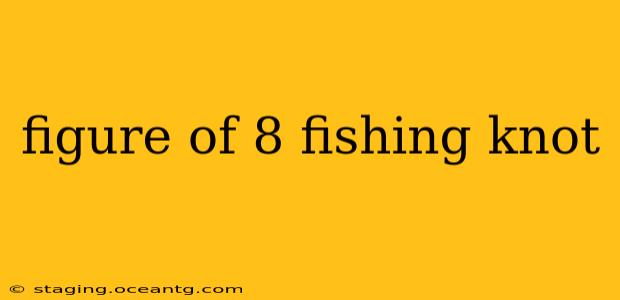The Figure 8 knot is a fundamental knot in fishing, prized for its simplicity, strength, and reliability. It's a go-to choice for anglers of all skill levels, serving as a crucial component in various fishing techniques. This comprehensive guide will delve into the intricacies of tying this essential knot, addressing common questions and misconceptions.
What is a Figure 8 Knot Used For?
The Figure 8 knot's primary function is to create a secure loop at the end of your fishing line. This loop can then be used for attaching various terminal tackle, including:
- Swivels: Preventing line twist and improving lure action.
- Leaders: Protecting your main line from abrasion.
- Lures: Directly attaching lures or connecting them to swivels.
- Hooks: Creating a loop for attaching hooks to your line.
Its versatility makes it an indispensable knot in almost every fishing situation.
How to Tie a Figure 8 Knot: A Step-by-Step Guide
Tying a secure Figure 8 knot is crucial for preventing line breakage and lost catches. Follow these steps carefully:
-
Form the Loop: Start by creating a loop in your fishing line, approximately the size you need for your terminal tackle.
-
The First Figure 8: Pass the working end of the line over and around the standing line (the main part of your fishing line), forming a figure 8 shape. Make sure the loop is not twisted.
-
The Second Figure 8: Now, pass the working end of the line through the loop you just created, again forming another figure 8.
-
Tighten the Knot: Gently pull both the standing line and the working end to tighten the knot. Be careful not to pull too hard, as this could damage your line.
-
Trim the Excess: Once the knot is tight, trim the excess line close to the knot, leaving a small tail.
Is the Figure 8 Knot Strong?
Yes, the Figure 8 knot is known for its strength and reliability. When tied correctly, it retains a significant percentage of the line's original breaking strength. However, remember that knot strength is also dependent on the line material and the quality of the knot itself. Improper tying can significantly weaken the knot.
What are the Advantages of Using a Figure 8 Knot?
- Simplicity: Easy to learn and tie, even for beginners.
- Strength: Retains a high percentage of the line's breaking strength.
- Versatility: Suitable for various fishing applications and line types.
- Reliability: A consistently secure knot when tied correctly.
What are Some Common Mistakes When Tying a Figure 8 Knot?
- Pulling Too Tight Too Soon: This can damage the line and weaken the knot.
- Twisted Loops: Twisted loops create uneven stress points, potentially leading to knot failure.
- Insufficient Tightening: A loosely tied Figure 8 knot won't hold securely.
What is the Difference Between a Figure 8 Knot and an Improved Clinch Knot?
While both are popular knots for attaching lures and other terminal tackle, they differ in their construction and applications. The Figure 8 knot is primarily used for creating a loop, whereas the Improved Clinch Knot is designed to create a direct connection between the line and the hook or lure. The Improved Clinch knot generally offers slightly higher breaking strength in a direct connection scenario, but the Figure 8's looped design offers advantages for specific applications.
Can I Use a Figure 8 Knot with Braided Line?
Yes, the Figure 8 knot is suitable for use with braided line. However, remember to always wet the line before tightening the knot to reduce friction and improve its strength.
By understanding the intricacies and proper execution of the Figure 8 knot, you'll significantly enhance your fishing experience, ensuring your line holds strong and secure, no matter the catch. Remember practice makes perfect – take some time to hone your skills and ensure you're confident in tying a strong, reliable knot every time.
